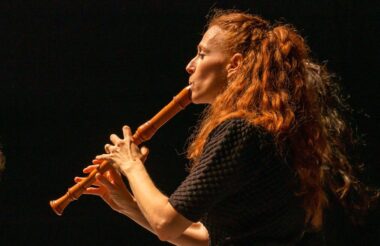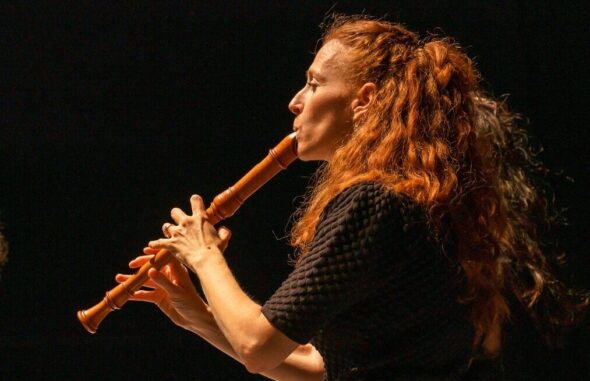 United States Vivaldi, Telemann – Virtuoso Brilliance’: Daphna Mor (recorder), HyunKun Cho (viola da gamba), Emi Tanabe, Chloe Fedor, Edwin Huizinga and Carrie Krause (violins), Apollo’s Fire / Alan Choo (violin and direction). First United Methodist Church, Akron, 6.2.2025. (MSJ)
United States Vivaldi, Telemann – Virtuoso Brilliance’: Daphna Mor (recorder), HyunKun Cho (viola da gamba), Emi Tanabe, Chloe Fedor, Edwin Huizinga and Carrie Krause (violins), Apollo’s Fire / Alan Choo (violin and direction). First United Methodist Church, Akron, 6.2.2025. (MSJ)

Vivaldi – Sinfonia from L’Olimpiade, RV725; Chaconne in C from RV114 (arr.Sorrell); Concerto in C minor for two violins, RV509; Concerto in B minor for four violins, RV580
Telemann – Overture-Suite in A minor, TWV55:a2; Concerto for Recorder & Gamba in A minor, TWV52:a1
Apollo’s Fire founder Jeannette Sorrell has been building the ensemble for over three decades in northeast Ohio, and in recent years began building a bridge to the future to ensure that they will continue long after she retires or, as seems the case lately, gets called all over the world to conduct. A few years back, she named Alan Choo as a resident artist in development and later named him assistant director. As Choo has developed as a violin soloist, he has also worked at developing leadership skills. This concert saw Choo completely in charge of a concert of intriguing virtuoso concertos, some familiar, others rare. It bodes well for the future that the ensemble continues to thrive whether Sorrell is physically present on the stage or not.
While Choo’s playing acumen is an irresistible asset, it is important to point out that he brought more to the concert than his own virtuosity. Whether soloing or supporting other soloists, Choo’s attention was everywhere, making eye contact with other players to help shape the musical exchanges, and keeping an eye on the audience to keep them engaged. Choo was in pole position for several pieces by Baroque master Antonio Vivaldi. Particularly intriguing was the Concerto in C minor for two violins which was made famous in the 1950s and 1960s by recordings that featured Isaac Stern as primary soloist. As good as those were, this performance offered more in terms of variety of attack, flexibility of pulse and sheer brilliance. In classic Apollo’s Fire manner, the soloists were strikingly different in tonal style. Choo’s sound was dark and silky but with piercing focus, while Chloe Fedor’s tone was considerably brighter yet more diffuse. The difference made it easy for the ear to follow the entangled solo lines, even in the fastest parts of the work.
The evening’s closer was the exciting four-violin Concerto in B minor. It was probably the first Vivaldi concerto other than The Four Seasons that I learned as a young listener, and it has remained a favorite ever since. (As an aside, it was one of J. S. Bach’s favorites, which we know because ‘his’ four-harpsichord concerto BWV1065 is just an arrangement of the Vivaldi.) From the first movement’s insistent entanglements to the twitchy, nervous slow movement to a blisteringly fast finale, this performance was quite simply the best I have heard (and that includes a past outing by this very ensemble). Choo was joined by Edwin Huizinga, Emi Tanabe and Carrie Krause, all fiercely committed but flashing different instrumental colors in their solos while other members of the ensemble pitched in feverishly as Vivaldi’s ideas ran riot.
Yet, for all the brilliant glory of the Vivaldi, the unexpected stars of the evening were the soft and delicate instruments featured in two concertos by Georg Phillip Gelemann, Vivaldi’s German contemporary. The great George Frideric Handel once said, in a mix of admiration and frustration, that Telemann could write a new piece of music as easily as anyone else could write a letter. And it is true that Telemann’s sheer productivity is probably unmatched in the history of music. But that doesn’t mean that he wrote everything without careful consideration. For instance, the two concertos on this program were both tailored to highlight instruments that were fading from popularity even as he wrote the pieces and were soon to become forgotten byways of music history.

The Overture-Suite in A minor for recorder and orchestra is one of Telemann’s most popular works and rightly so. It combines his fluid creativity with a pan-European diversity. The work is built around the elegant style of a French suite, yet Telemann interpolates elements of instrumental virtuosity close to the frenetic Italian style of Vivaldi. He even includes one movement, ‘Air à l’Italien’, which transforms the recorder from bird-like whistle into an almost operatic singer. A pair of polonaise dances refers to the folk music of eastern Europe, while the whole thing is assembled with a characteristic Germanic thoroughness. It covers a lot of ground, gives the recorder a championship workout (seven movements running 25 minutes!) and remains compelling throughout. Daphna Mor did more than cover the thousands of notes, she inhabited them and brought them to dancing life. I first learned this piece from an early period-instrument recording by Hans-Martin Linde, but Mor and Apollo’s Fire brought new levels of personality and risk to the music. They also wisely moved the ‘Réjouissance’ movement from fifth position in the suite to seventh, to end with brilliance.
Smaller but utterly enchanting was the Concerto for recorder and viola da gamba. Telemann’s example is the only known concerto for the two instruments, both of which are soft and delicate in tone. That is why they were gradually dropped from the orchestra as ensembles began to favor more dynamic instruments. Here Mor was joined by HyunKun Cho, who drew both singing swells and sparkling passagework out of the normally intractable gamba, an instrument often drowned out, even in Baroque ensemble pieces. It turns out the subdued voices of the two sparked a kind of magic in tandem. It would be a joy to see modern composers take up the challenge of writing further recorder/viola da gamba concertos.
Sorrell was still on hand, in a way, as the arranger of Vivaldi’s Chaconne in C, another one for Choo and Tanabe. The concert also brought the rarely heard Sinfonia from Vivaldi’s L’Olimpiade, one of only about twenty surviving operas by a composer said to have written nearly a hundred.
The program balanced familiar favorites and intriguing rarities, and it was received with great warmth by the Akron audience. It will be interesting to see if Apollo’s Fire has to turn more to other venues for concerts in the future: it was recently announced that the First United Methodist Church is closing to merge with another church into a smaller facility. In a public statement carried on local media, the church confirmed that it will remain open for scheduled music events through May or June, but the future of the handsome venue is up in the air after then. While Apollo’s Fire has played in other Akron venues, the FUMC has proven both popular and central. One hopes a path can be found for its continued use.
Mark Sebastian Jordan
